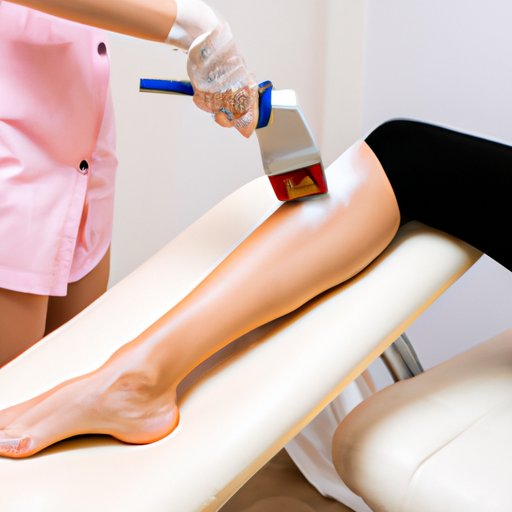Introduction
Laser hair removal is one of the most popular treatments for those looking to reduce unwanted body hair. It offers a permanent solution that reduces the need for frequent waxing or shaving. The treatment works by targeting the pigment in the hair follicle with an intense beam of light, which damages the follicle and stops it from producing new hair growth. However, it’s important to remember that laser hair removal isn’t an overnight miracle cure; it takes time for the full results to become visible.
In this article, we’ll take a look at what to expect after laser hair removal and provide a guide to post-treatment care. We’ll also explore the pros and cons of waiting to shave after laser hair removal, as well as compare waxing and shaving after the procedure.
A Guide to Post-Laser Hair Removal Care
Once you’ve had laser hair removal, there are certain steps you should take to ensure your skin recovers properly. This includes avoiding direct sunlight, using gentle cleansers, and applying moisturizer regularly. Additionally, it’s important to understand how long you should wait to shave after laser hair removal.
How Long Should You Wait to Shave After Laser Hair Removal?
Most experts recommend waiting between three and seven days after your laser hair removal treatment before you start shaving. This gives your skin enough time to heal, as shaving too soon can lead to irritation and inflammation. During this period, use a gentle, non-abrasive cleanser on the area and avoid exfoliating products.
What Happens if You Shave Too Soon After Laser Hair Removal?
Shaving too soon after laser hair removal can lead to a number of potential complications. For starters, it can irritate the area, leading to redness and swelling. You may also experience a burning sensation when you shave, as the razor can disrupt the healing process. Additionally, shaving too soon could cause ingrown hairs and other skin infections.

Pros and Cons of Waiting to Shave After Laser Hair Removal
Waiting to shave after laser hair removal can be inconvenient and time consuming. However, it’s also important to consider the benefits of doing so. Let’s take a look at the pros and cons of waiting to shave after laser hair removal.
Benefits of Waiting to Shave After Laser Hair Removal
The main benefit of waiting to shave after laser hair removal is that it allows your skin to heal properly. By giving your skin the time it needs to recover, you can reduce the risk of irritation, inflammation, and infection. Additionally, waiting to shave gives the laser hair removal treatment more time to work, meaning you may see better results.
Drawbacks of Waiting to Shave After Laser Hair Removal
The main drawback of waiting to shave after laser hair removal is that it can be inconvenient and time consuming. Additionally, some people may find that their skin becomes more sensitive during this period, making shaving more uncomfortable than usual.
Is It Safe to Shave Immediately After Laser Hair Removal?
It’s generally not recommended to shave immediately after laser hair removal. While it’s possible to do so, it’s important to understand the risks involved. Shaving too soon can lead to irritation, inflammation, and infection, so it’s best to wait until your skin has healed.
Understanding the Risks Involved
As mentioned above, shaving too soon after laser hair removal can lead to a number of potential complications. These include irritation, inflammation, and infection. Additionally, shaving too soon can disrupt the laser hair removal treatment, meaning you may not see the desired results.
What to Do If You Decide to Shave Immediately After Laser Hair Removal
If you decide to shave immediately after laser hair removal, it’s important to take extra care. Make sure you use a sharp, clean razor and apply a generous amount of shaving cream or gel. Additionally, use short, gentle strokes and avoid pressing down too hard. Finally, make sure you rinse the area thoroughly after shaving to reduce the risk of irritation.
Comparing Waxing and Shaving After Laser Hair Removal
Once your skin has healed after laser hair removal, you can choose to either shave or wax. Both methods have their advantages and disadvantages, so let’s take a look at the pros and cons of each option.
Advantages of Waxing After Laser Hair Removal
The main advantage of waxing after laser hair removal is that it removes hair more effectively. Waxing pulls the entire hair out of the follicle, meaning it takes longer for the hair to grow back. Additionally, waxing can help to prevent ingrown hairs and irritation.
Advantages of Shaving After Laser Hair Removal
The main advantage of shaving after laser hair removal is that it’s quick and easy. Additionally, shaving doesn’t require any special equipment or products, making it a convenient option for those with busy lifestyles. Shaving also offers a closer shave than waxing, meaning you may see better results.
Conclusion
Laser hair removal can offer a permanent solution for those looking to reduce unwanted body hair. However, it’s important to understand how to care for your skin after the procedure to ensure the best results. Most experts recommend waiting between three and seven days after laser hair removal before you start shaving. This gives your skin the time it needs to heal properly. Additionally, it’s important to consider the pros and cons of both waxing and shaving after the procedure. By following these tips, you can ensure that your laser hair removal treatment is successful.
(Note: Is this article not meeting your expectations? Do you have knowledge or insights to share? Unlock new opportunities and expand your reach by joining our authors team. Click Registration to join us and share your expertise with our readers.)
